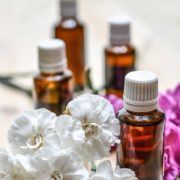What is essential in essential oil?
Reeder MJ. Allergic Contact Dermatitis to Fragrances. Dermatol Clin. 2020;38(3):371‐377. doi:10.1016/j.det.2020.02.009
Reviewed by Jalal Maghfour and Dr. Alina Goldenberg, MD
Essential oils (EOs) are the quintessential oils in flowers, stems, seeds, leaves, roots and berries. Although the name “essential” may imply purity, in reality, EOs are processed hydrophobic volatile compounds from raw plant material with various stabilizing additives. Nevertheless, since ancient times, EOs have been used for skin beauty, cosmetics and treatments of various conditions such as pain and anxiety and continue to be highly marketed today despite their intrinsic risks.
The extraction of EOs is by no means simple. Common techniques for extraction include distillation and cold compression. Because of their hydrophobicity, the addition of a solvent is often required for both extraction and dilution of EOs. Solvents may include petroleum ether, methanol, and ethanol These solvents may be toxic pesticides such as methanol which has been associated with nausea, vomiting, headache, blurred vision, permanent blindness, seizures, coma, permanent damage to the nervous system or death. . Hence, there is no such a thing as “pure” essential oil.
Historically, EOs have been perceived as safe. This misconception is rooted from the fact that all herbs are considered safe because they are ‘natural’. This has led to an increase in use and misuse of EOs With increased popularity of EOs for aromatherapy, there has been an expansion of EOs use in other products, even in EO products advertised for their efficacy in treating various disorders including dermatologic conditions. While the FDA can enforce guidelines to restrict how products are marketed, it is important to recognize that EOs are not FDA regulated.
It is therefore not surprising that increased accessibility of these products by the public has led to an increase in their use. In dermatology, EO induced Allergic contact dermatitis (ACD) is not new to clinicians but it is becoming increasingly more prevalent. In fact, fragrances, which also contain EOs as ingredients, have been designated as the 2007 allergen of the year, by the American Contact Dermatitis Society (ACDS).
EO-induced ACD is of clinical importance as standard patch testing may miss EO sensitizations. If there is high suspicion for an EO allergy, it is important to perform expanded patch testing to avoid false negative results. In the US, melaluca (tea tree) and ylang ylang are common allergenic oils that could be potentially missed if testing was limited to standard fragrance.
Another common myth is that toxicity of EOs correlates with dose concentration. In reality, all EOs can be toxic at high concentrations but there are some types of EOs that are inherently toxic even at low doses, especially when taken orally . Camphor is a very toxic compound which can prove fatal for infants and children on ingestion even in very small doses. The strong aroma associated with camphor has attracted its use in many EOs, especially as a remedy for the common cold. Patients who ingested camphor can develop severe nausea, vomiting, lethargy, ataxia, and even seizures. Inhaling eucalyptus offers a soothing effect when suffering from a cold, however ingestion of eucalyptus oils can lead to seizures. Nutmeg is an EO which enhances food flavor; misusing it can lead to hallucinations and coma. Thus, even ‘safe’ EOs can be detrimental to patients if misused. Even EOs advertised as non-toxic have the potential to be toxic to certain vulnerable individuals and age groups (babies, elderly) and/or if taken for a long period of time.
In summary, although some EOs have been recognized to have beneficial properties, they have the potential to be extremely hazardous and dangerous to humans. It is vital for patients to appreciate the complexity of EOs and be aware of the fact that they are not as “pure” nor as free of risks as advertised.

